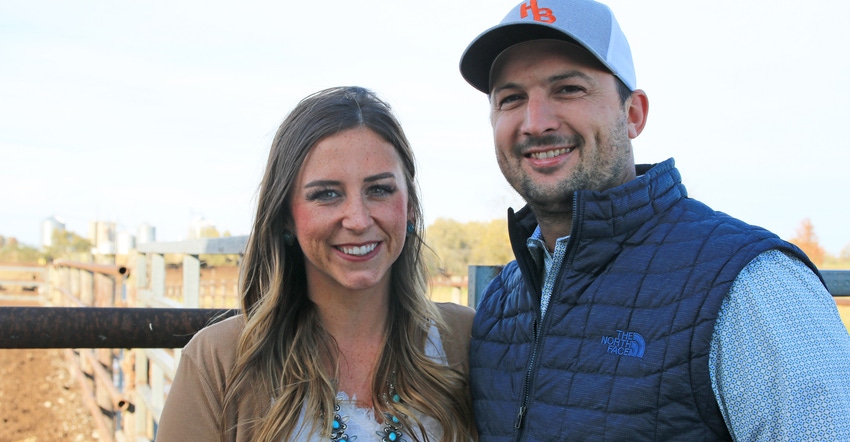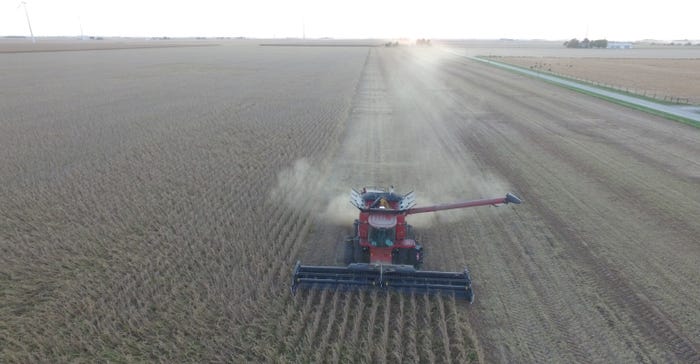
Reeder and Lena Head of Blue Mound, Ill., bought their first tract of land together ahead of spring planting in 2018. Despite not having a lot of cash or equity, the young couple could afford the 45 acres of Grade A ground with help from the Farm Service Agency’s beginning farmer loan program.
The down payment loan the Heads applied for required a payment of 5% of the purchase price of the farm, while FSA financed 45% with a fixed interest rate of 1.5% for 20 years. The remaining 50% is financed by a lender, in their case, Farm Credit Illinois, at a discount for the first five years because the Heads are members of its lending assistance program for beginning farmers, FreshRoots.
“Normally, you’d have to come up with 30% down, but it depends on your equity situation. It was nice we didn’t have to have as much cash to put down on the farm — that made it a lot easier for us,” says Reeder, who farms with his father, Malcolm, and his brother Rollin at Head Bros. Land and Cattle. Rollin will also be buying land through the FSA program.
When the land came up for sale just a half-mile away from their house, the Heads seized the opportunity, almost reaching the cap of what they could borrow from FSA at the time. The FSA Direct Down Payment Farm Ownership Program now tops out at $300,150.
“Forty-five acres turned out to be the perfect fit,” Lena says. �“It allowed us to maximize the available money of this program without overextending ourselves.” She works off-farm as a product manager at GSI, a division of Agco.
“They do give you cheap money, but they want to make sure you’re going to pay them back,” Reeder adds.

PLANTING: Reeder was busy planting when he and Lena purchased their first field together. FSA requires signed contracts before farmers can apply for loans to purchase land.

He says he was busy with planting when they closed on the land at the end of May 2018, so FSA and Farm Credit helped to push through tax and cash flow records, diplomas and other paperwork.
“The approval process after you submit the paperwork takes a little bit of time,” Reeder says. “That’s why a private sale usually works better, because you’re not trying to close within a short window. You need over a month or so to get everything approved.” He notes the owners of the land he and Lena bought offered it to them privately at a reasonable price.
Since auction ground usually needs to be closed on within a month, it’s hard to work into FSA-aided land purchases that need a little over that amount of time to process. FSA requires a signed contract to formally apply.
While the 50-45-5 loan arrangement from FSA is only open to farmers who are in the first 10 years of their careers, the agency also offers a 50% FSA-funded loan without that requirement with a 2.5% interest rate. The other 50% is covered by the farmer’s lender.
Not so easy money
Under programs like FreshRoots at Farm Credit and Groundbreakers at Compeer Financial, beginning farmers get relaxed underwriting standards and discounts on the non-FSA portions of their loan packages.
“When somebody joins FreshRoots, it’s not just about giving relaxed credit standards and cheap interest rates. It’s also about financial management training and helping members become more profitable and efficient,” says Derek Stayton, Farm Credit Illinois vice president of lending, referring to annual reporting requirements for FreshRoots. Some documents are also required by FSA, including an annual year-end balance sheet and cash flow statement.
Sometimes a lender will use the Illinois Finance Authority’s beginning farmer bond program in combination with FSA offerings. The state issues a bond to cover the 50% loan with a 30-year repayment schedule and allows the bank to pass interest rate savings on to the borrower, says Mark Cox, vice president of agricultural lending at First Mid Bank and Trust.
In 2019, he put together loan packages for three beginning farmers using both programs to buy land.
“I would say the number of requests has been reduced with higher land prices, but we still see opportunities in the market that come up for young farmers,” Cox says.
He’s seen scenarios where the parent actually buys a farm at an auction, and it’s all prearranged to where once the land is acquired, “you can buy it from your parent, and we just put the wheels in motion after the sale to go ahead and process the young farmer loan,” Cox says, adding, “It does add some added legal and title expense, but ends up being worth it.”
Class A ground
The FSA loan packages are often used within families to take the first step toward transitioning land to the next generation. FSA also offers a loan guarantee program for banks, though with relaxed underwriting standards for new farmers, the loan guarantee is rarely needed, says Dustin Wright, financial officer at Compeer Financial in Bourbonnais, Ill.
“We typically don’t need a loan guarantee from FSA,” Wright says. “If they’re doubling their acreage, then we would use FSA for a couple of years. The guarantees are good, but they cost the borrower money, so we try not to have that extra cost unless we absolutely need to.”
When asked if they were nervous about their recent land acquisition, Lena and Reeder reported the field yielded 230 bushels per acre in their second harvest in spite of the tough 2019 season.
“You could wait for land prices to come down to do what we did,” Lena says.
“But you might be waiting a while,” Reeder concludes. “They seem to have flattened out around that $10,000 range for that Class A ground. It holds its value.”

HARVEST: The Heads have harvested two crops off the land they bought in May 2018.

Lender facts
Here’s a quick look at two Illinois ag lenders:
Compeer Financial. This northern Illinois lender also spans Minnesota and Wisconsin. It’s part of the Farm Credit System and gave out 43,388 loans to young farmers in 2019, with a total volume of $7.4 billion. About 15% of those borrowers also used FSA beginning farmer loans.
Farm Credit Illinois. Since its FreshRoots program was launched in 2018, this central and southern credit provider gave out 1,070 loans to 838 different beginning farmers with a total volume of $200 million in total loan commitments. FCI has paid learning incentives totaling $1,048,500 to 765 different beginning borrowers who collectively submitted 1,379 different vouchers for attending learning programs.
About the Author(s)
You May Also Like




